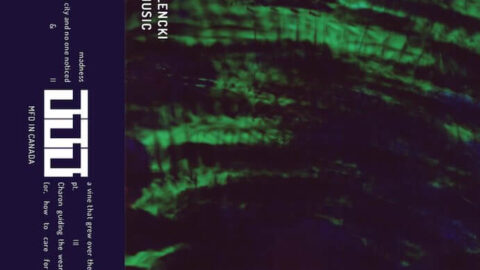In the past decade, Weston Olencki’s work as a multifaceted artist has explored the limits of instruments and electronic systems to create abstract visceral pieces. Out May 13, 2022 on Tripticks Tapes, their newest album, Old Time Music, invests in place and tradition by examining how the tenor saxophone, banjo, and pump organ are entangled in broader “cultural and material histories.” At its best, Old Time Music uses technological experimentation to raise poignant questions about the living musical traditions of America.
tenor madness explores the history of tenor saxophone improvisation in the recording studio. A machine listening program stands in for tradition, creating a unique sound from a library of 300 recorded tenor saxophone excerpts from 1939 to the present. On the album, tenor saxophonist Anna Webber leads the program through an improvisation that shifts from frenzied ensemble textures to a poetic dialogue. Eventually, the lines between human and computer improviser are blurred as the program’s sounds blend with the long poetic phrases in Webber’s final solo. This freewheeling improvisation suggests that post-human abstraction is part of an evolving tradition. Yet, an unprocessed sample at the end of the piece seems to leave this idea open: What does the program contribute musically and socially to the living traditions it draws from?

a vine that grew over the city and no one noticed uses AI programs, field recordings, and archival recordings to meditate on industrialization in North and South Carolina. AM radio sounds evoke traditions of radio listening in rural/industrial life while connecting the piece’s four movements that explore the region’s soundscapes and musical traditions.
“Cripple Creek // Pretty Polly” finds the resonances between bluegrass banjo traditions and 20th century industrialization. Two dueling “electromechanical” banjos use a machine learning program to turn fragments from bluegrass songs into a relentless drone that loosely resembles a “Scruggs Style” picking pattern. This abstract mechanized version of traditional bluegrass blends into archival recordings of locomotives that once traced the region. However, like the economies and machines that supported Carolinian mill-towns, the electromechanical banjos gradually falter into glitching repeated notes and static drones.
“Saluda Grade //Moonshiner” features sparse whirring and pitched samples that give way to mechanized sounds, creating thick smoky textures of machines slowly groaning back online. Evoking the human side of industrialization, processed samples echo moaning voices, gasping breaths, and labor/ballad song traditions. Following similar themes, “Nacthmusik” depicts an industrial landscape that has returned to nature with field-recordings of cicadas and other insects. The movement develops the percussive sounds of found objects into a blistering cacophony. Radio static, banjo picking, and reverb pierce the natural sounds, seemly contesting romanticized rhythms of post-industrial life.

“The by and by” is grounded in the distinctly human experience of coming home and listening to the radio after a day at work. Yet, the presumed listener settles on a post-modern radio collage that places the Carter Family’s “Can the Circle be Unbroken” alongside well-known covers and almost recognizable versions created by Open AI’s Jukebox program. This reflective moment ties together themes from the previous movements, but also raises a question that haunts the piece — What remains in the wake of industrialization and deindustrialization: people, songs, machines, or nature?
Charon guiding the weary ‘cross the Long River (or, how to care for a dying instrument) directly engages this question by combining sounds from Sacred Harp singing and the detritus of extractive marble industries in Vermont. In the video and album version, four computer-controlled reed organs and electronically animated objects reverberate through an abandoned marble quarry in East Dorset, Vermont. Absent are the typical chorus of exuberant Sacred Harp singers that have continuously gathered in New England since the 1700s. Instead, each of the instruments falter and fall silent, the last of which is a foot laboring to keep the pump organ going and the sound of the Connecticut river.
In my own research in Appalachia, I’m reminded that “old time music” is indelibly social, community based, and participatory. In this context, I listen to Old Time Music in dialogue with those working to shape tradition from within. I hear Emily Hilliard and Saro Lynch Thomason who are working at the edges of institutional and grass roots archives to recuperate women’s voices in folk and bluegrass music circles. I’m listening with Olencki’s Sonic Blanket, and work by Anna and Elizabeth, Nate May, and Brian Harnetty, which all blur the boundaries between experimentation, technology, and tradition while engaging with local and regional communities.
Old Time Music exists on the edge of a larger socio-cultural moment where many artists are inviting listeners to closely examine the intersecting resonances of tradition and extractive economies in our day-to-day lives — especially in the wake of deindustrialization. Olencki excels at blending computer processes with field and archival recordings to illuminate the histories of objects, instruments, and places. Yet, the album’s use of AI and machine learning warp the human and social aspects that are so vital to tradition. The project ultimately opens rather than answers questions about how tradition is abstracted, the nuances of social music making, and why and how traditions live on.
I CARE IF YOU LISTEN is an editorially-independent program of the American Composers Forum, funded with generous donor and institutional support. Opinions expressed are solely those of the author and may not represent the views of ICIYL or ACF.
A gift to ACF helps support the work of ICIYL. For more on ACF, visit the “At ACF” section or composersforum.org.
























